Coronavirus Biology: Literature Review, NS 103 Biology Exam
VerifiedAdded on 2022/09/18
|18
|4295
|19
Report
AI Summary
This report is a literature review on the biology of coronaviruses, focusing primarily on the recent emergence of SARS-CoV-2 (COVID-19). The review synthesizes information from various research papers, primarily sourced from PubMed, published between 2019 and 2020. The report examines the virus's mechanisms, including host-pathogen interactions, viral replication, and the role of specific viral proteins like S1-NTD and S1-CTD in cell entry. It also explores the impact of host immunity and hygiene practices. The review investigates the effectiveness of antiviral drugs like remdesivir and chloroquine, as well as the potential of monoclonal antibody therapy. Additionally, the report discusses the origin, transmission, and clinical symptoms of the virus, including fever and cough, and the use of imaging techniques like computed tomography. The review emphasizes the need for further research on novel antiviral strategies and the development of effective vaccination and treatment methods. The report also includes a literature review matrix summarizing key aspects of the included research papers.
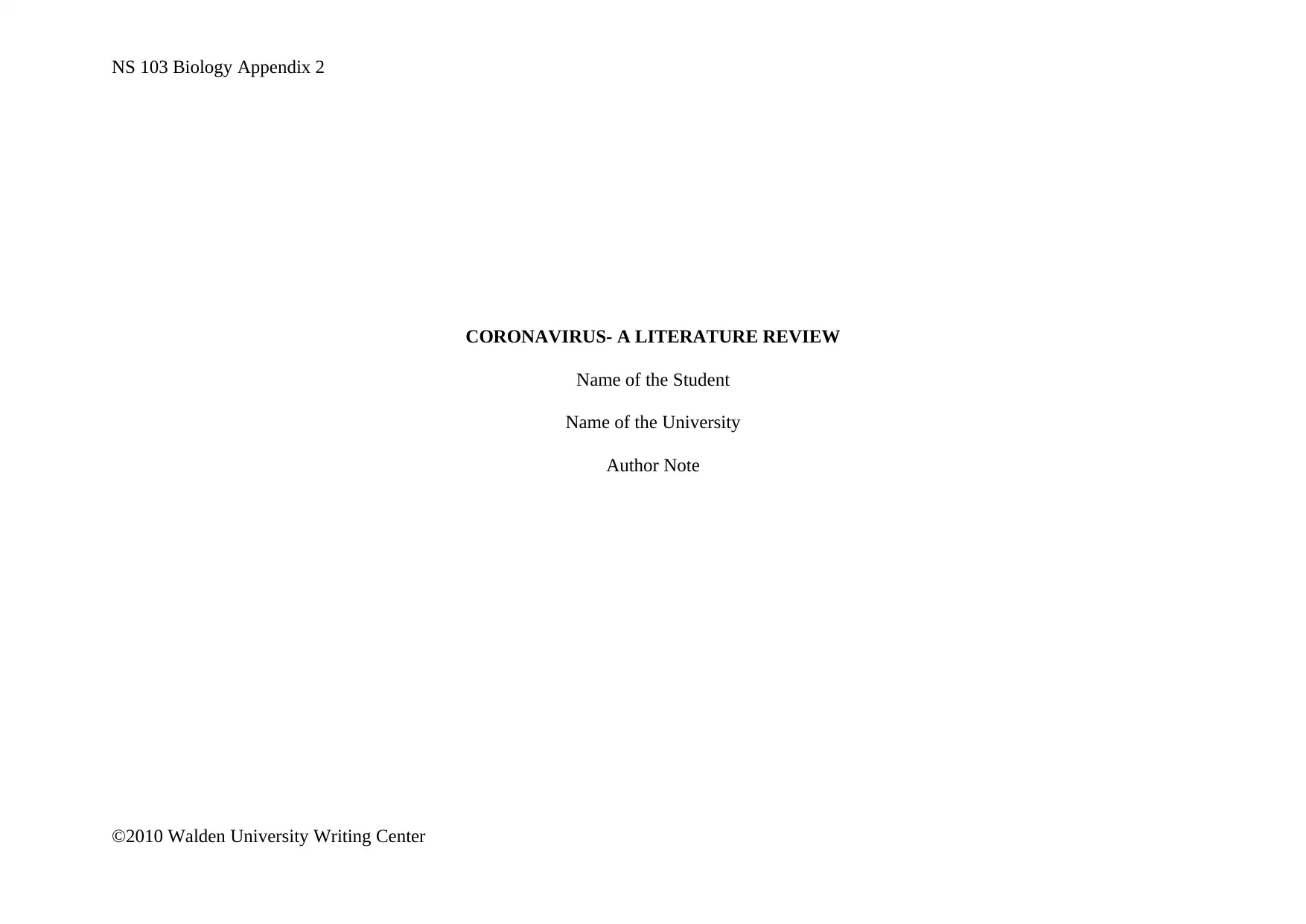
NS 103 Biology Appendix 2
CORONAVIRUS- A LITERATURE REVIEW
Name of the Student
Name of the University
Author Note
©2010 Walden University Writing Center
CORONAVIRUS- A LITERATURE REVIEW
Name of the Student
Name of the University
Author Note
©2010 Walden University Writing Center
Paraphrase This Document
Need a fresh take? Get an instant paraphrase of this document with our AI Paraphraser
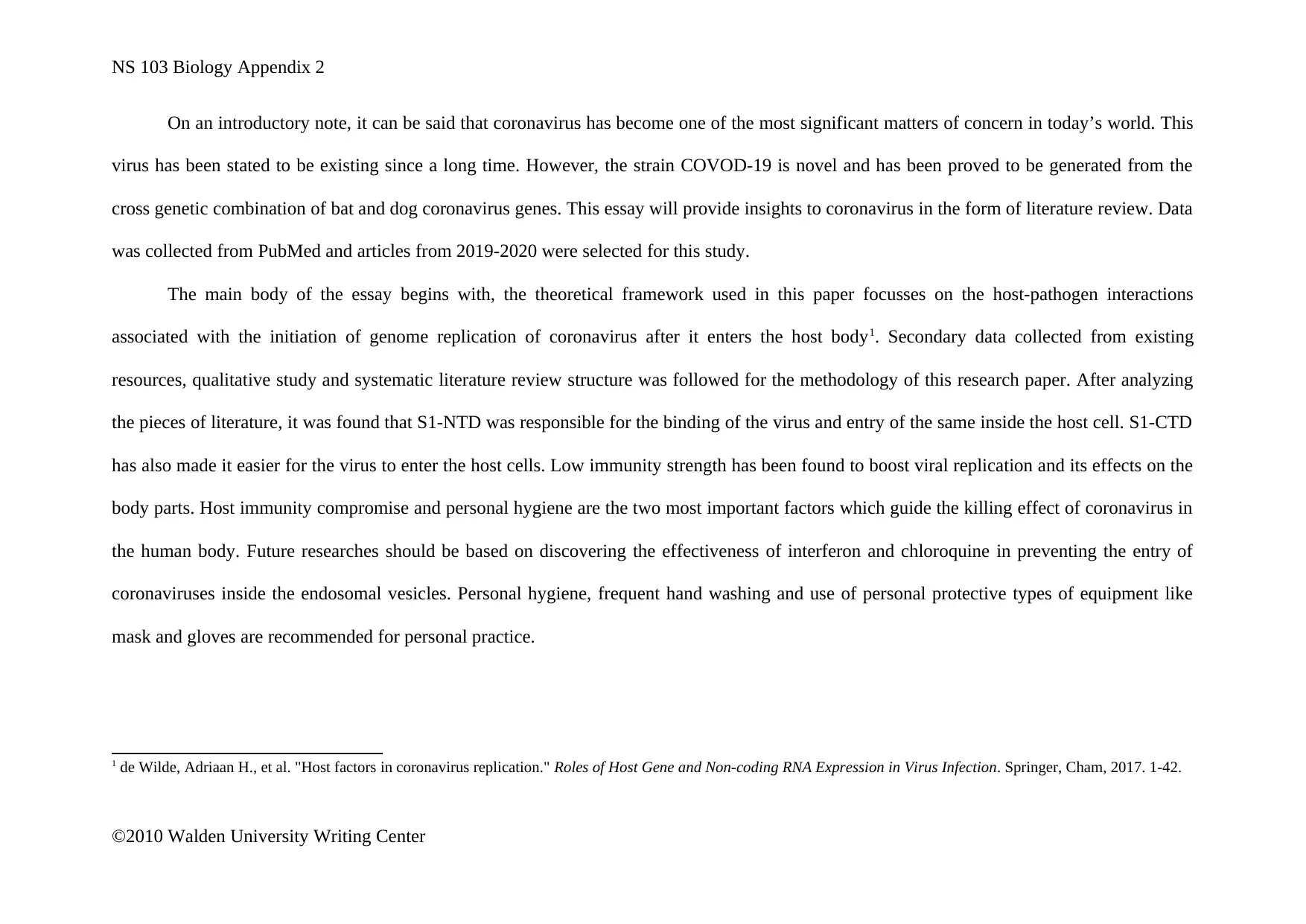
NS 103 Biology Appendix 2
On an introductory note, it can be said that coronavirus has become one of the most significant matters of concern in today’s world. This
virus has been stated to be existing since a long time. However, the strain COVOD-19 is novel and has been proved to be generated from the
cross genetic combination of bat and dog coronavirus genes. This essay will provide insights to coronavirus in the form of literature review. Data
was collected from PubMed and articles from 2019-2020 were selected for this study.
The main body of the essay begins with, the theoretical framework used in this paper focusses on the host-pathogen interactions
associated with the initiation of genome replication of coronavirus after it enters the host body1. Secondary data collected from existing
resources, qualitative study and systematic literature review structure was followed for the methodology of this research paper. After analyzing
the pieces of literature, it was found that S1-NTD was responsible for the binding of the virus and entry of the same inside the host cell. S1-CTD
has also made it easier for the virus to enter the host cells. Low immunity strength has been found to boost viral replication and its effects on the
body parts. Host immunity compromise and personal hygiene are the two most important factors which guide the killing effect of coronavirus in
the human body. Future researches should be based on discovering the effectiveness of interferon and chloroquine in preventing the entry of
coronaviruses inside the endosomal vesicles. Personal hygiene, frequent hand washing and use of personal protective types of equipment like
mask and gloves are recommended for personal practice.
1 de Wilde, Adriaan H., et al. "Host factors in coronavirus replication." Roles of Host Gene and Non-coding RNA Expression in Virus Infection. Springer, Cham, 2017. 1-42.
©2010 Walden University Writing Center
On an introductory note, it can be said that coronavirus has become one of the most significant matters of concern in today’s world. This
virus has been stated to be existing since a long time. However, the strain COVOD-19 is novel and has been proved to be generated from the
cross genetic combination of bat and dog coronavirus genes. This essay will provide insights to coronavirus in the form of literature review. Data
was collected from PubMed and articles from 2019-2020 were selected for this study.
The main body of the essay begins with, the theoretical framework used in this paper focusses on the host-pathogen interactions
associated with the initiation of genome replication of coronavirus after it enters the host body1. Secondary data collected from existing
resources, qualitative study and systematic literature review structure was followed for the methodology of this research paper. After analyzing
the pieces of literature, it was found that S1-NTD was responsible for the binding of the virus and entry of the same inside the host cell. S1-CTD
has also made it easier for the virus to enter the host cells. Low immunity strength has been found to boost viral replication and its effects on the
body parts. Host immunity compromise and personal hygiene are the two most important factors which guide the killing effect of coronavirus in
the human body. Future researches should be based on discovering the effectiveness of interferon and chloroquine in preventing the entry of
coronaviruses inside the endosomal vesicles. Personal hygiene, frequent hand washing and use of personal protective types of equipment like
mask and gloves are recommended for personal practice.
1 de Wilde, Adriaan H., et al. "Host factors in coronavirus replication." Roles of Host Gene and Non-coding RNA Expression in Virus Infection. Springer, Cham, 2017. 1-42.
©2010 Walden University Writing Center
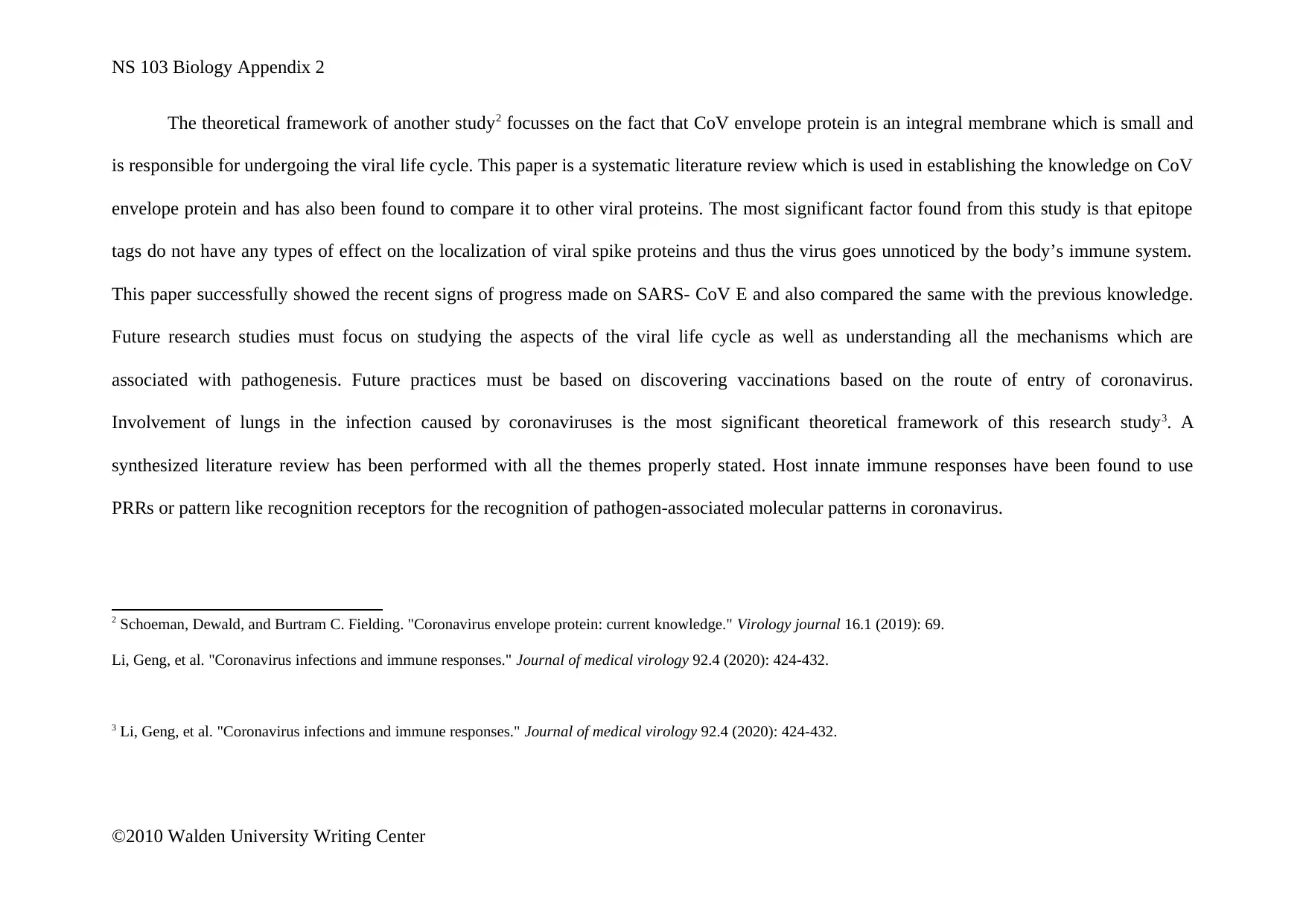
NS 103 Biology Appendix 2
The theoretical framework of another study2 focusses on the fact that CoV envelope protein is an integral membrane which is small and
is responsible for undergoing the viral life cycle. This paper is a systematic literature review which is used in establishing the knowledge on CoV
envelope protein and has also been found to compare it to other viral proteins. The most significant factor found from this study is that epitope
tags do not have any types of effect on the localization of viral spike proteins and thus the virus goes unnoticed by the body’s immune system.
This paper successfully showed the recent signs of progress made on SARS- CoV E and also compared the same with the previous knowledge.
Future research studies must focus on studying the aspects of the viral life cycle as well as understanding all the mechanisms which are
associated with pathogenesis. Future practices must be based on discovering vaccinations based on the route of entry of coronavirus.
Involvement of lungs in the infection caused by coronaviruses is the most significant theoretical framework of this research study3. A
synthesized literature review has been performed with all the themes properly stated. Host innate immune responses have been found to use
PRRs or pattern like recognition receptors for the recognition of pathogen-associated molecular patterns in coronavirus.
2 Schoeman, Dewald, and Burtram C. Fielding. "Coronavirus envelope protein: current knowledge." Virology journal 16.1 (2019): 69.
Li, Geng, et al. "Coronavirus infections and immune responses." Journal of medical virology 92.4 (2020): 424-432.
3 Li, Geng, et al. "Coronavirus infections and immune responses." Journal of medical virology 92.4 (2020): 424-432.
©2010 Walden University Writing Center
The theoretical framework of another study2 focusses on the fact that CoV envelope protein is an integral membrane which is small and
is responsible for undergoing the viral life cycle. This paper is a systematic literature review which is used in establishing the knowledge on CoV
envelope protein and has also been found to compare it to other viral proteins. The most significant factor found from this study is that epitope
tags do not have any types of effect on the localization of viral spike proteins and thus the virus goes unnoticed by the body’s immune system.
This paper successfully showed the recent signs of progress made on SARS- CoV E and also compared the same with the previous knowledge.
Future research studies must focus on studying the aspects of the viral life cycle as well as understanding all the mechanisms which are
associated with pathogenesis. Future practices must be based on discovering vaccinations based on the route of entry of coronavirus.
Involvement of lungs in the infection caused by coronaviruses is the most significant theoretical framework of this research study3. A
synthesized literature review has been performed with all the themes properly stated. Host innate immune responses have been found to use
PRRs or pattern like recognition receptors for the recognition of pathogen-associated molecular patterns in coronavirus.
2 Schoeman, Dewald, and Burtram C. Fielding. "Coronavirus envelope protein: current knowledge." Virology journal 16.1 (2019): 69.
Li, Geng, et al. "Coronavirus infections and immune responses." Journal of medical virology 92.4 (2020): 424-432.
3 Li, Geng, et al. "Coronavirus infections and immune responses." Journal of medical virology 92.4 (2020): 424-432.
©2010 Walden University Writing Center
⊘ This is a preview!⊘
Do you want full access?
Subscribe today to unlock all pages.

Trusted by 1+ million students worldwide
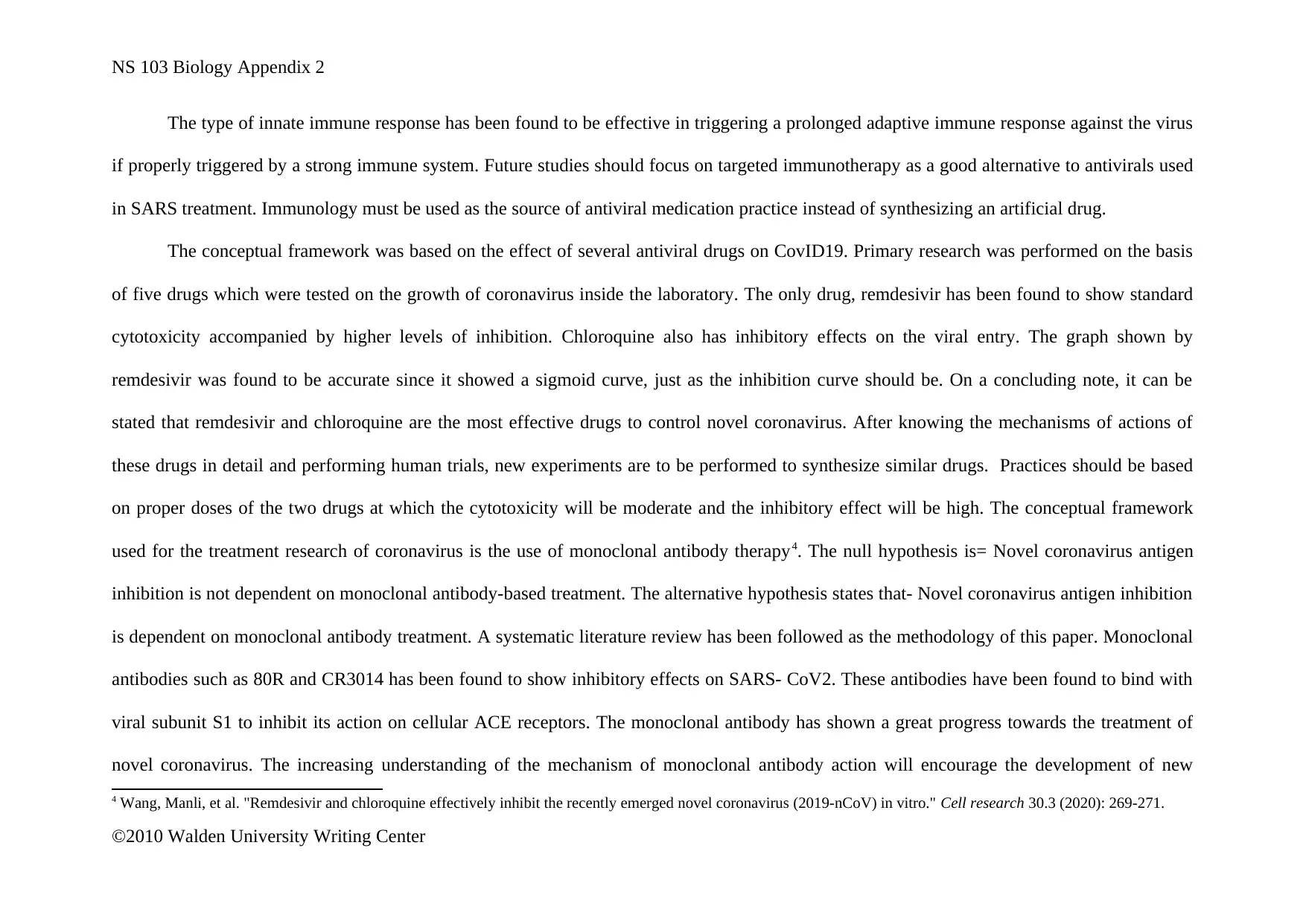
NS 103 Biology Appendix 2
The type of innate immune response has been found to be effective in triggering a prolonged adaptive immune response against the virus
if properly triggered by a strong immune system. Future studies should focus on targeted immunotherapy as a good alternative to antivirals used
in SARS treatment. Immunology must be used as the source of antiviral medication practice instead of synthesizing an artificial drug.
The conceptual framework was based on the effect of several antiviral drugs on CovID19. Primary research was performed on the basis
of five drugs which were tested on the growth of coronavirus inside the laboratory. The only drug, remdesivir has been found to show standard
cytotoxicity accompanied by higher levels of inhibition. Chloroquine also has inhibitory effects on the viral entry. The graph shown by
remdesivir was found to be accurate since it showed a sigmoid curve, just as the inhibition curve should be. On a concluding note, it can be
stated that remdesivir and chloroquine are the most effective drugs to control novel coronavirus. After knowing the mechanisms of actions of
these drugs in detail and performing human trials, new experiments are to be performed to synthesize similar drugs. Practices should be based
on proper doses of the two drugs at which the cytotoxicity will be moderate and the inhibitory effect will be high. The conceptual framework
used for the treatment research of coronavirus is the use of monoclonal antibody therapy4. The null hypothesis is= Novel coronavirus antigen
inhibition is not dependent on monoclonal antibody-based treatment. The alternative hypothesis states that- Novel coronavirus antigen inhibition
is dependent on monoclonal antibody treatment. A systematic literature review has been followed as the methodology of this paper. Monoclonal
antibodies such as 80R and CR3014 has been found to show inhibitory effects on SARS- CoV2. These antibodies have been found to bind with
viral subunit S1 to inhibit its action on cellular ACE receptors. The monoclonal antibody has shown a great progress towards the treatment of
novel coronavirus. The increasing understanding of the mechanism of monoclonal antibody action will encourage the development of new
4 Wang, Manli, et al. "Remdesivir and chloroquine effectively inhibit the recently emerged novel coronavirus (2019-nCoV) in vitro." Cell research 30.3 (2020): 269-271.
©2010 Walden University Writing Center
The type of innate immune response has been found to be effective in triggering a prolonged adaptive immune response against the virus
if properly triggered by a strong immune system. Future studies should focus on targeted immunotherapy as a good alternative to antivirals used
in SARS treatment. Immunology must be used as the source of antiviral medication practice instead of synthesizing an artificial drug.
The conceptual framework was based on the effect of several antiviral drugs on CovID19. Primary research was performed on the basis
of five drugs which were tested on the growth of coronavirus inside the laboratory. The only drug, remdesivir has been found to show standard
cytotoxicity accompanied by higher levels of inhibition. Chloroquine also has inhibitory effects on the viral entry. The graph shown by
remdesivir was found to be accurate since it showed a sigmoid curve, just as the inhibition curve should be. On a concluding note, it can be
stated that remdesivir and chloroquine are the most effective drugs to control novel coronavirus. After knowing the mechanisms of actions of
these drugs in detail and performing human trials, new experiments are to be performed to synthesize similar drugs. Practices should be based
on proper doses of the two drugs at which the cytotoxicity will be moderate and the inhibitory effect will be high. The conceptual framework
used for the treatment research of coronavirus is the use of monoclonal antibody therapy4. The null hypothesis is= Novel coronavirus antigen
inhibition is not dependent on monoclonal antibody-based treatment. The alternative hypothesis states that- Novel coronavirus antigen inhibition
is dependent on monoclonal antibody treatment. A systematic literature review has been followed as the methodology of this paper. Monoclonal
antibodies such as 80R and CR3014 has been found to show inhibitory effects on SARS- CoV2. These antibodies have been found to bind with
viral subunit S1 to inhibit its action on cellular ACE receptors. The monoclonal antibody has shown a great progress towards the treatment of
novel coronavirus. The increasing understanding of the mechanism of monoclonal antibody action will encourage the development of new
4 Wang, Manli, et al. "Remdesivir and chloroquine effectively inhibit the recently emerged novel coronavirus (2019-nCoV) in vitro." Cell research 30.3 (2020): 269-271.
©2010 Walden University Writing Center
Paraphrase This Document
Need a fresh take? Get an instant paraphrase of this document with our AI Paraphraser
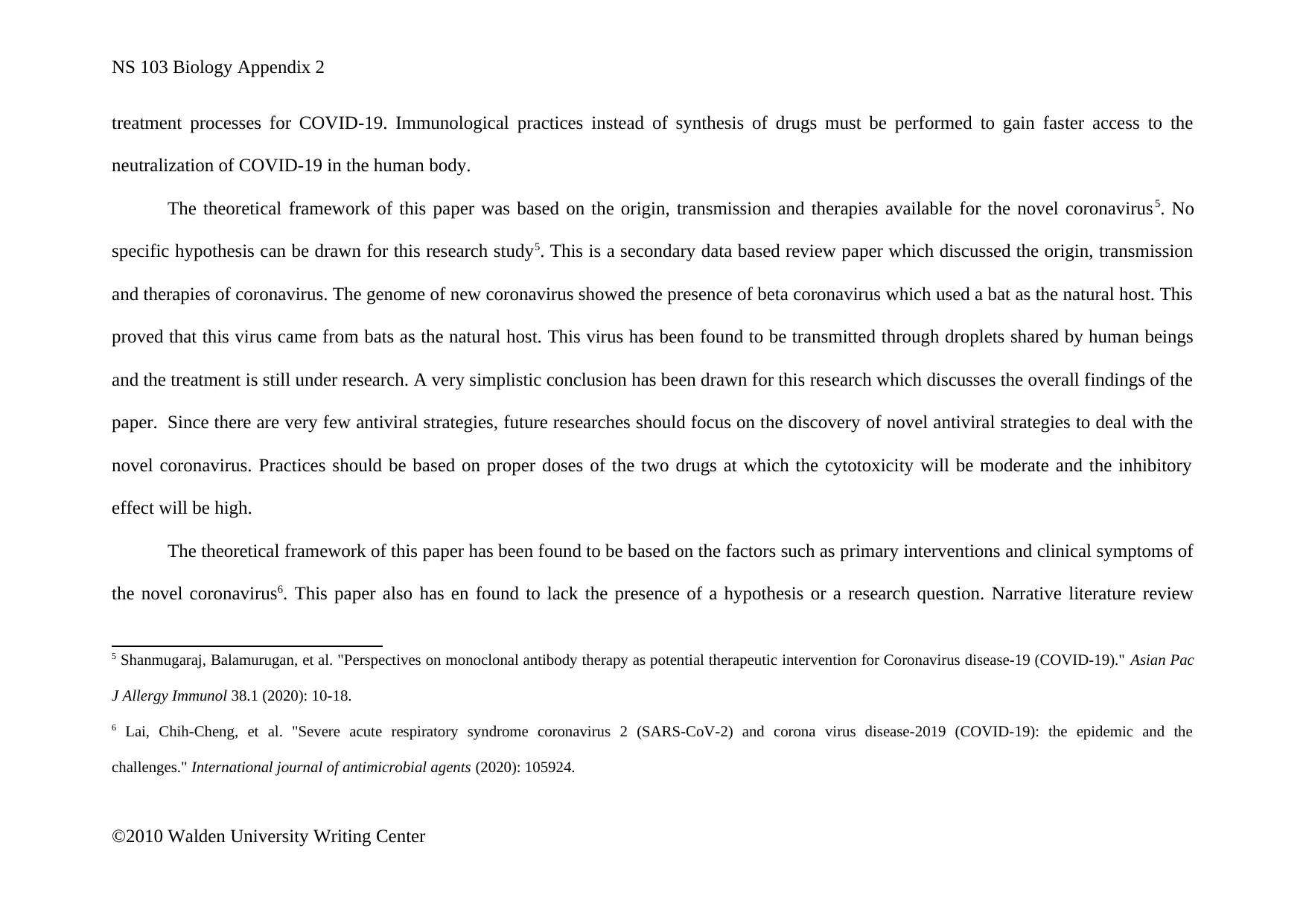
NS 103 Biology Appendix 2
treatment processes for COVID-19. Immunological practices instead of synthesis of drugs must be performed to gain faster access to the
neutralization of COVID-19 in the human body.
The theoretical framework of this paper was based on the origin, transmission and therapies available for the novel coronavirus5. No
specific hypothesis can be drawn for this research study5. This is a secondary data based review paper which discussed the origin, transmission
and therapies of coronavirus. The genome of new coronavirus showed the presence of beta coronavirus which used a bat as the natural host. This
proved that this virus came from bats as the natural host. This virus has been found to be transmitted through droplets shared by human beings
and the treatment is still under research. A very simplistic conclusion has been drawn for this research which discusses the overall findings of the
paper. Since there are very few antiviral strategies, future researches should focus on the discovery of novel antiviral strategies to deal with the
novel coronavirus. Practices should be based on proper doses of the two drugs at which the cytotoxicity will be moderate and the inhibitory
effect will be high.
The theoretical framework of this paper has been found to be based on the factors such as primary interventions and clinical symptoms of
the novel coronavirus6. This paper also has en found to lack the presence of a hypothesis or a research question. Narrative literature review
5 Shanmugaraj, Balamurugan, et al. "Perspectives on monoclonal antibody therapy as potential therapeutic intervention for Coronavirus disease-19 (COVID-19)." Asian Pac
J Allergy Immunol 38.1 (2020): 10-18.
6 Lai, Chih-Cheng, et al. "Severe acute respiratory syndrome coronavirus 2 (SARS-CoV-2) and corona virus disease-2019 (COVID-19): the epidemic and the
challenges." International journal of antimicrobial agents (2020): 105924.
©2010 Walden University Writing Center
treatment processes for COVID-19. Immunological practices instead of synthesis of drugs must be performed to gain faster access to the
neutralization of COVID-19 in the human body.
The theoretical framework of this paper was based on the origin, transmission and therapies available for the novel coronavirus5. No
specific hypothesis can be drawn for this research study5. This is a secondary data based review paper which discussed the origin, transmission
and therapies of coronavirus. The genome of new coronavirus showed the presence of beta coronavirus which used a bat as the natural host. This
proved that this virus came from bats as the natural host. This virus has been found to be transmitted through droplets shared by human beings
and the treatment is still under research. A very simplistic conclusion has been drawn for this research which discusses the overall findings of the
paper. Since there are very few antiviral strategies, future researches should focus on the discovery of novel antiviral strategies to deal with the
novel coronavirus. Practices should be based on proper doses of the two drugs at which the cytotoxicity will be moderate and the inhibitory
effect will be high.
The theoretical framework of this paper has been found to be based on the factors such as primary interventions and clinical symptoms of
the novel coronavirus6. This paper also has en found to lack the presence of a hypothesis or a research question. Narrative literature review
5 Shanmugaraj, Balamurugan, et al. "Perspectives on monoclonal antibody therapy as potential therapeutic intervention for Coronavirus disease-19 (COVID-19)." Asian Pac
J Allergy Immunol 38.1 (2020): 10-18.
6 Lai, Chih-Cheng, et al. "Severe acute respiratory syndrome coronavirus 2 (SARS-CoV-2) and corona virus disease-2019 (COVID-19): the epidemic and the
challenges." International journal of antimicrobial agents (2020): 105924.
©2010 Walden University Writing Center
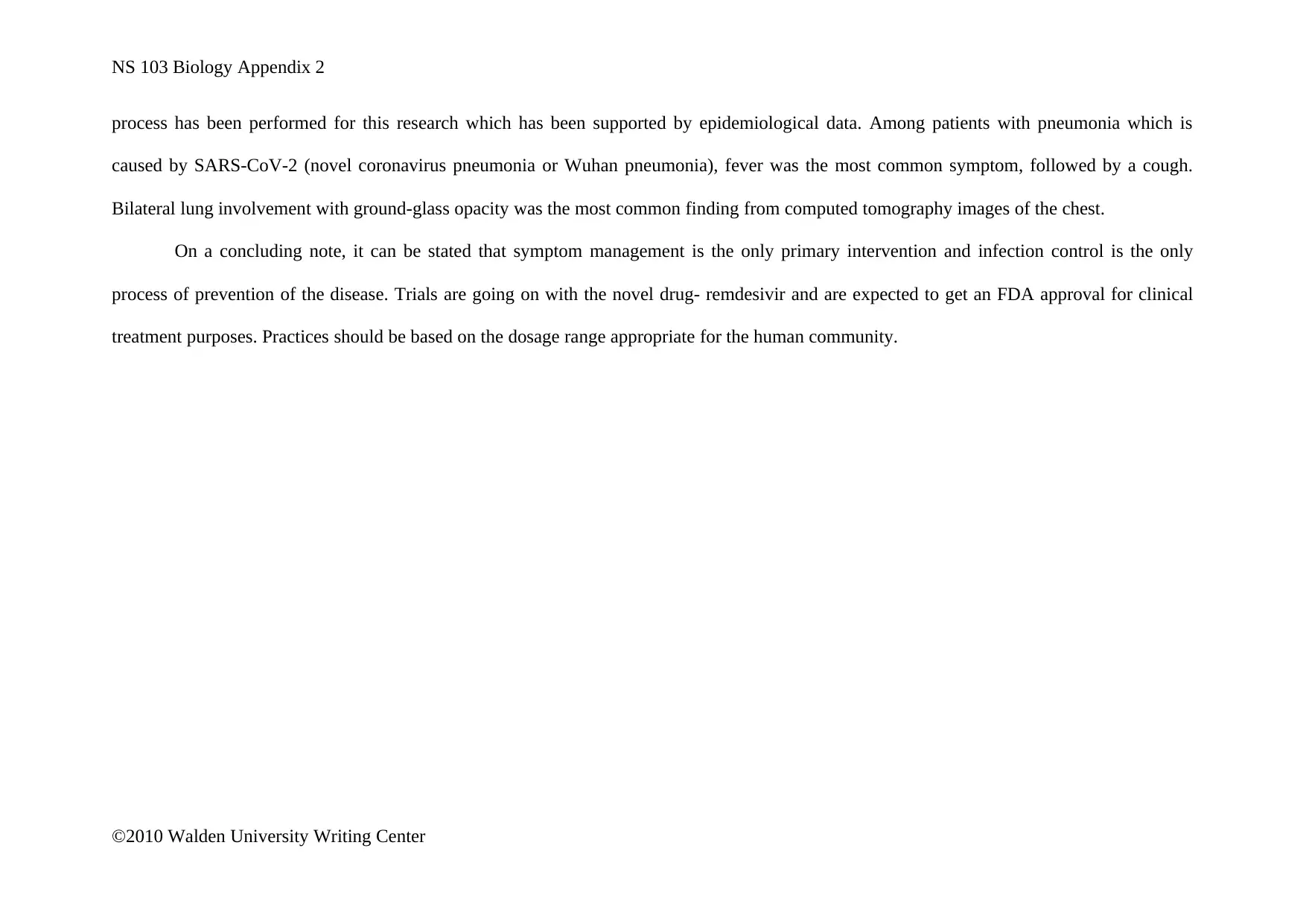
NS 103 Biology Appendix 2
process has been performed for this research which has been supported by epidemiological data. Among patients with pneumonia which is
caused by SARS-CoV-2 (novel coronavirus pneumonia or Wuhan pneumonia), fever was the most common symptom, followed by a cough.
Bilateral lung involvement with ground-glass opacity was the most common finding from computed tomography images of the chest.
On a concluding note, it can be stated that symptom management is the only primary intervention and infection control is the only
process of prevention of the disease. Trials are going on with the novel drug- remdesivir and are expected to get an FDA approval for clinical
treatment purposes. Practices should be based on the dosage range appropriate for the human community.
©2010 Walden University Writing Center
process has been performed for this research which has been supported by epidemiological data. Among patients with pneumonia which is
caused by SARS-CoV-2 (novel coronavirus pneumonia or Wuhan pneumonia), fever was the most common symptom, followed by a cough.
Bilateral lung involvement with ground-glass opacity was the most common finding from computed tomography images of the chest.
On a concluding note, it can be stated that symptom management is the only primary intervention and infection control is the only
process of prevention of the disease. Trials are going on with the novel drug- remdesivir and are expected to get an FDA approval for clinical
treatment purposes. Practices should be based on the dosage range appropriate for the human community.
©2010 Walden University Writing Center
⊘ This is a preview!⊘
Do you want full access?
Subscribe today to unlock all pages.

Trusted by 1+ million students worldwide
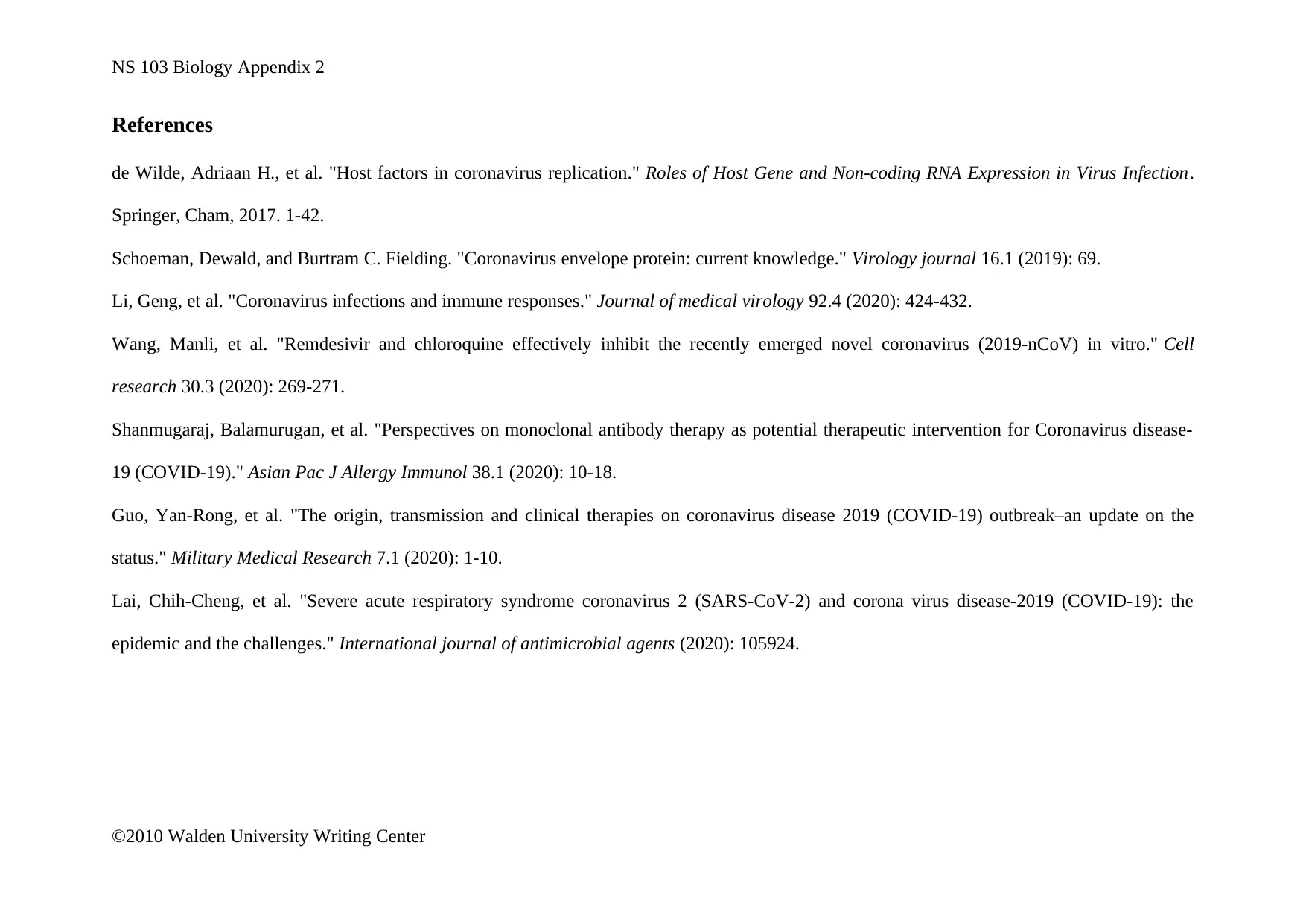
NS 103 Biology Appendix 2
References
de Wilde, Adriaan H., et al. "Host factors in coronavirus replication." Roles of Host Gene and Non-coding RNA Expression in Virus Infection.
Springer, Cham, 2017. 1-42.
Schoeman, Dewald, and Burtram C. Fielding. "Coronavirus envelope protein: current knowledge." Virology journal 16.1 (2019): 69.
Li, Geng, et al. "Coronavirus infections and immune responses." Journal of medical virology 92.4 (2020): 424-432.
Wang, Manli, et al. "Remdesivir and chloroquine effectively inhibit the recently emerged novel coronavirus (2019-nCoV) in vitro." Cell
research 30.3 (2020): 269-271.
Shanmugaraj, Balamurugan, et al. "Perspectives on monoclonal antibody therapy as potential therapeutic intervention for Coronavirus disease-
19 (COVID-19)." Asian Pac J Allergy Immunol 38.1 (2020): 10-18.
Guo, Yan-Rong, et al. "The origin, transmission and clinical therapies on coronavirus disease 2019 (COVID-19) outbreak–an update on the
status." Military Medical Research 7.1 (2020): 1-10.
Lai, Chih-Cheng, et al. "Severe acute respiratory syndrome coronavirus 2 (SARS-CoV-2) and corona virus disease-2019 (COVID-19): the
epidemic and the challenges." International journal of antimicrobial agents (2020): 105924.
©2010 Walden University Writing Center
References
de Wilde, Adriaan H., et al. "Host factors in coronavirus replication." Roles of Host Gene and Non-coding RNA Expression in Virus Infection.
Springer, Cham, 2017. 1-42.
Schoeman, Dewald, and Burtram C. Fielding. "Coronavirus envelope protein: current knowledge." Virology journal 16.1 (2019): 69.
Li, Geng, et al. "Coronavirus infections and immune responses." Journal of medical virology 92.4 (2020): 424-432.
Wang, Manli, et al. "Remdesivir and chloroquine effectively inhibit the recently emerged novel coronavirus (2019-nCoV) in vitro." Cell
research 30.3 (2020): 269-271.
Shanmugaraj, Balamurugan, et al. "Perspectives on monoclonal antibody therapy as potential therapeutic intervention for Coronavirus disease-
19 (COVID-19)." Asian Pac J Allergy Immunol 38.1 (2020): 10-18.
Guo, Yan-Rong, et al. "The origin, transmission and clinical therapies on coronavirus disease 2019 (COVID-19) outbreak–an update on the
status." Military Medical Research 7.1 (2020): 1-10.
Lai, Chih-Cheng, et al. "Severe acute respiratory syndrome coronavirus 2 (SARS-CoV-2) and corona virus disease-2019 (COVID-19): the
epidemic and the challenges." International journal of antimicrobial agents (2020): 105924.
©2010 Walden University Writing Center
Paraphrase This Document
Need a fresh take? Get an instant paraphrase of this document with our AI Paraphraser
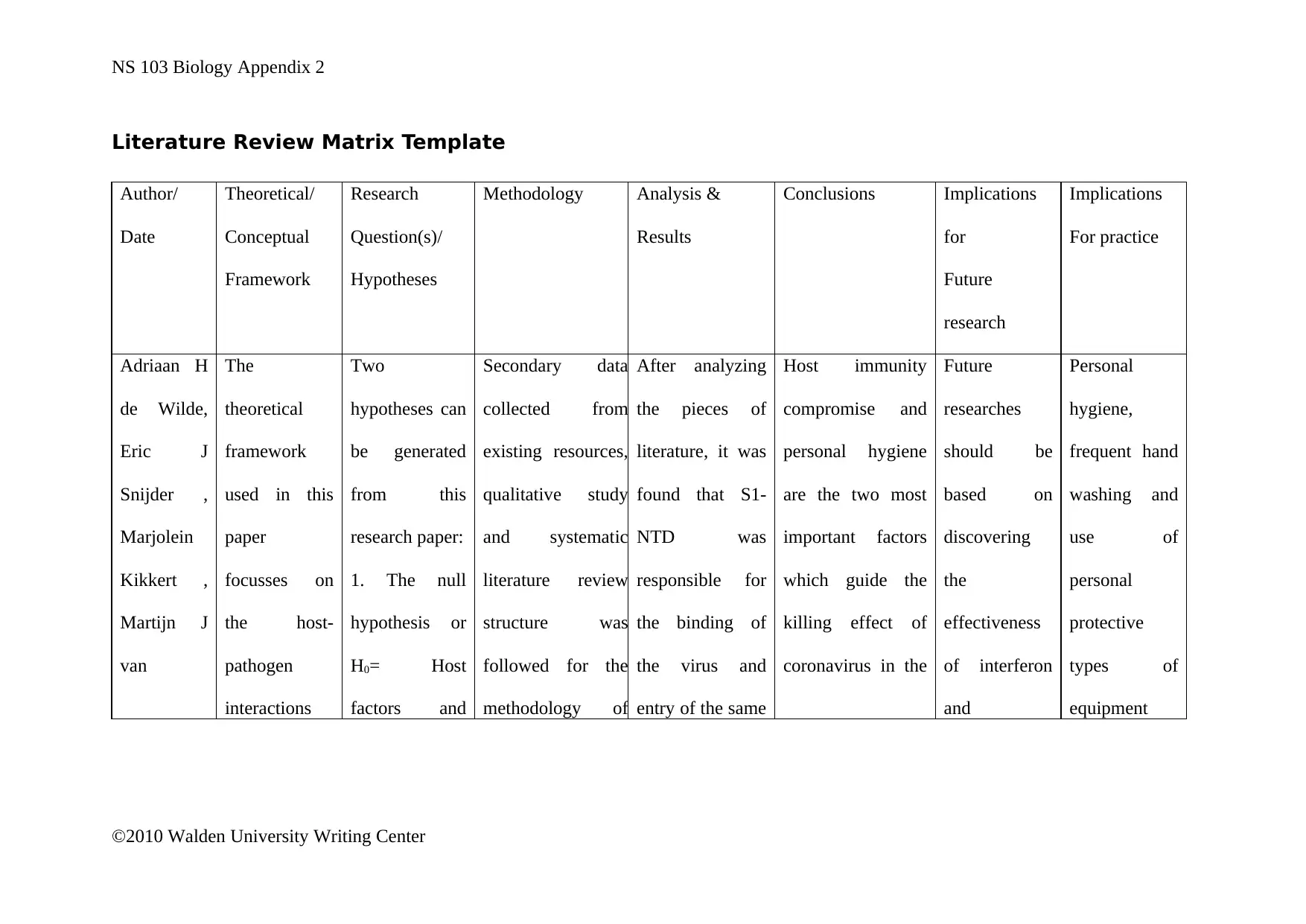
NS 103 Biology Appendix 2
Literature Review Matrix Template
Author/
Date
Theoretical/
Conceptual
Framework
Research
Question(s)/
Hypotheses
Methodology Analysis &
Results
Conclusions Implications
for
Future
research
Implications
For practice
Adriaan H
de Wilde,
Eric J
Snijder ,
Marjolein
Kikkert ,
Martijn J
van
The
theoretical
framework
used in this
paper
focusses on
the host-
pathogen
interactions
Two
hypotheses can
be generated
from this
research paper:
1. The null
hypothesis or
H0= Host
factors and
Secondary data
collected from
existing resources,
qualitative study
and systematic
literature review
structure was
followed for the
methodology of
After analyzing
the pieces of
literature, it was
found that S1-
NTD was
responsible for
the binding of
the virus and
entry of the same
Host immunity
compromise and
personal hygiene
are the two most
important factors
which guide the
killing effect of
coronavirus in the
Future
researches
should be
based on
discovering
the
effectiveness
of interferon
and
Personal
hygiene,
frequent hand
washing and
use of
personal
protective
types of
equipment
©2010 Walden University Writing Center
Literature Review Matrix Template
Author/
Date
Theoretical/
Conceptual
Framework
Research
Question(s)/
Hypotheses
Methodology Analysis &
Results
Conclusions Implications
for
Future
research
Implications
For practice
Adriaan H
de Wilde,
Eric J
Snijder ,
Marjolein
Kikkert ,
Martijn J
van
The
theoretical
framework
used in this
paper
focusses on
the host-
pathogen
interactions
Two
hypotheses can
be generated
from this
research paper:
1. The null
hypothesis or
H0= Host
factors and
Secondary data
collected from
existing resources,
qualitative study
and systematic
literature review
structure was
followed for the
methodology of
After analyzing
the pieces of
literature, it was
found that S1-
NTD was
responsible for
the binding of
the virus and
entry of the same
Host immunity
compromise and
personal hygiene
are the two most
important factors
which guide the
killing effect of
coronavirus in the
Future
researches
should be
based on
discovering
the
effectiveness
of interferon
and
Personal
hygiene,
frequent hand
washing and
use of
personal
protective
types of
equipment
©2010 Walden University Writing Center
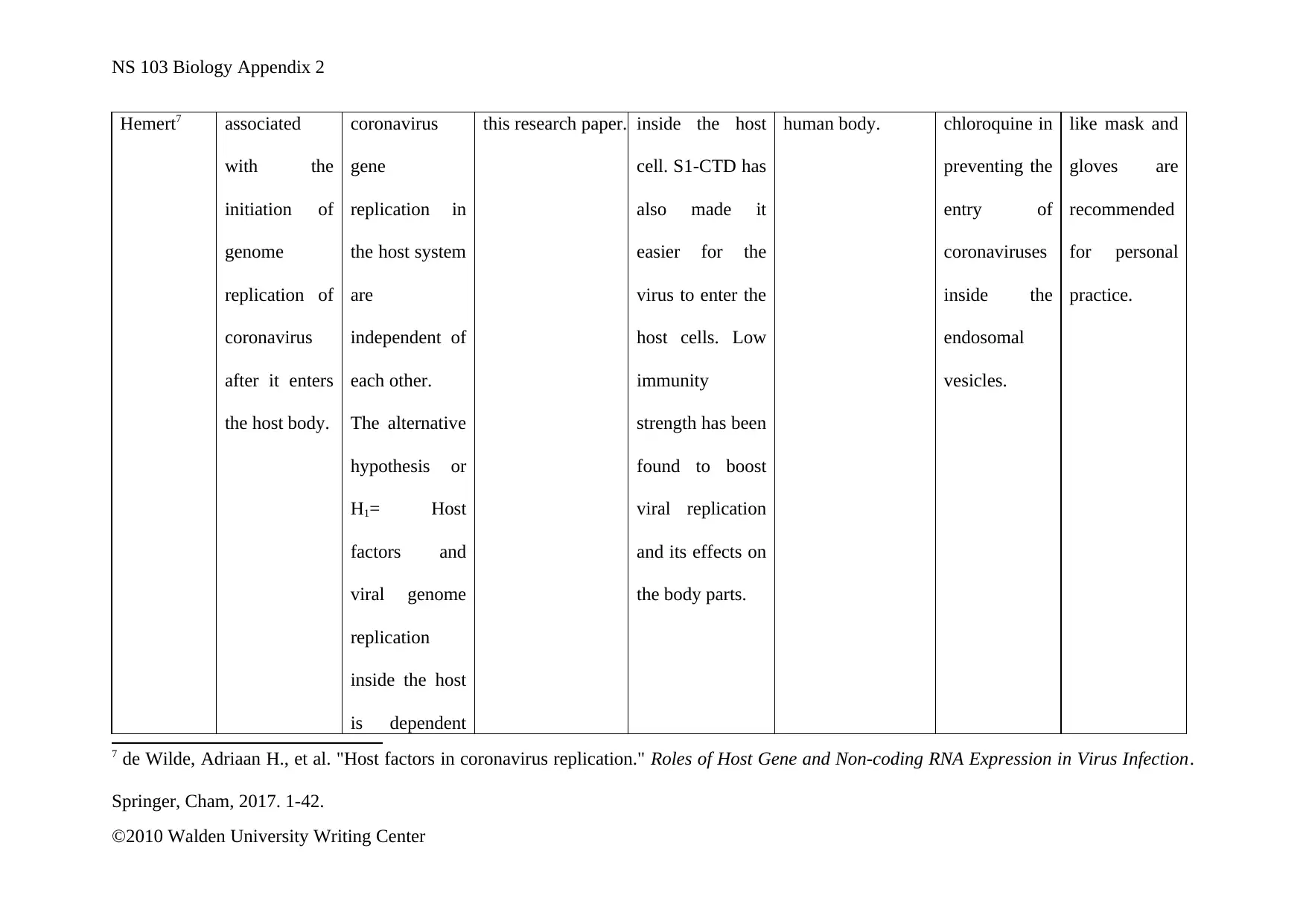
NS 103 Biology Appendix 2
Hemert7 associated
with the
initiation of
genome
replication of
coronavirus
after it enters
the host body.
coronavirus
gene
replication in
the host system
are
independent of
each other.
The alternative
hypothesis or
H1= Host
factors and
viral genome
replication
inside the host
is dependent
this research paper. inside the host
cell. S1-CTD has
also made it
easier for the
virus to enter the
host cells. Low
immunity
strength has been
found to boost
viral replication
and its effects on
the body parts.
human body. chloroquine in
preventing the
entry of
coronaviruses
inside the
endosomal
vesicles.
like mask and
gloves are
recommended
for personal
practice.
7 de Wilde, Adriaan H., et al. "Host factors in coronavirus replication." Roles of Host Gene and Non-coding RNA Expression in Virus Infection.
Springer, Cham, 2017. 1-42.
©2010 Walden University Writing Center
Hemert7 associated
with the
initiation of
genome
replication of
coronavirus
after it enters
the host body.
coronavirus
gene
replication in
the host system
are
independent of
each other.
The alternative
hypothesis or
H1= Host
factors and
viral genome
replication
inside the host
is dependent
this research paper. inside the host
cell. S1-CTD has
also made it
easier for the
virus to enter the
host cells. Low
immunity
strength has been
found to boost
viral replication
and its effects on
the body parts.
human body. chloroquine in
preventing the
entry of
coronaviruses
inside the
endosomal
vesicles.
like mask and
gloves are
recommended
for personal
practice.
7 de Wilde, Adriaan H., et al. "Host factors in coronavirus replication." Roles of Host Gene and Non-coding RNA Expression in Virus Infection.
Springer, Cham, 2017. 1-42.
©2010 Walden University Writing Center
⊘ This is a preview!⊘
Do you want full access?
Subscribe today to unlock all pages.

Trusted by 1+ million students worldwide
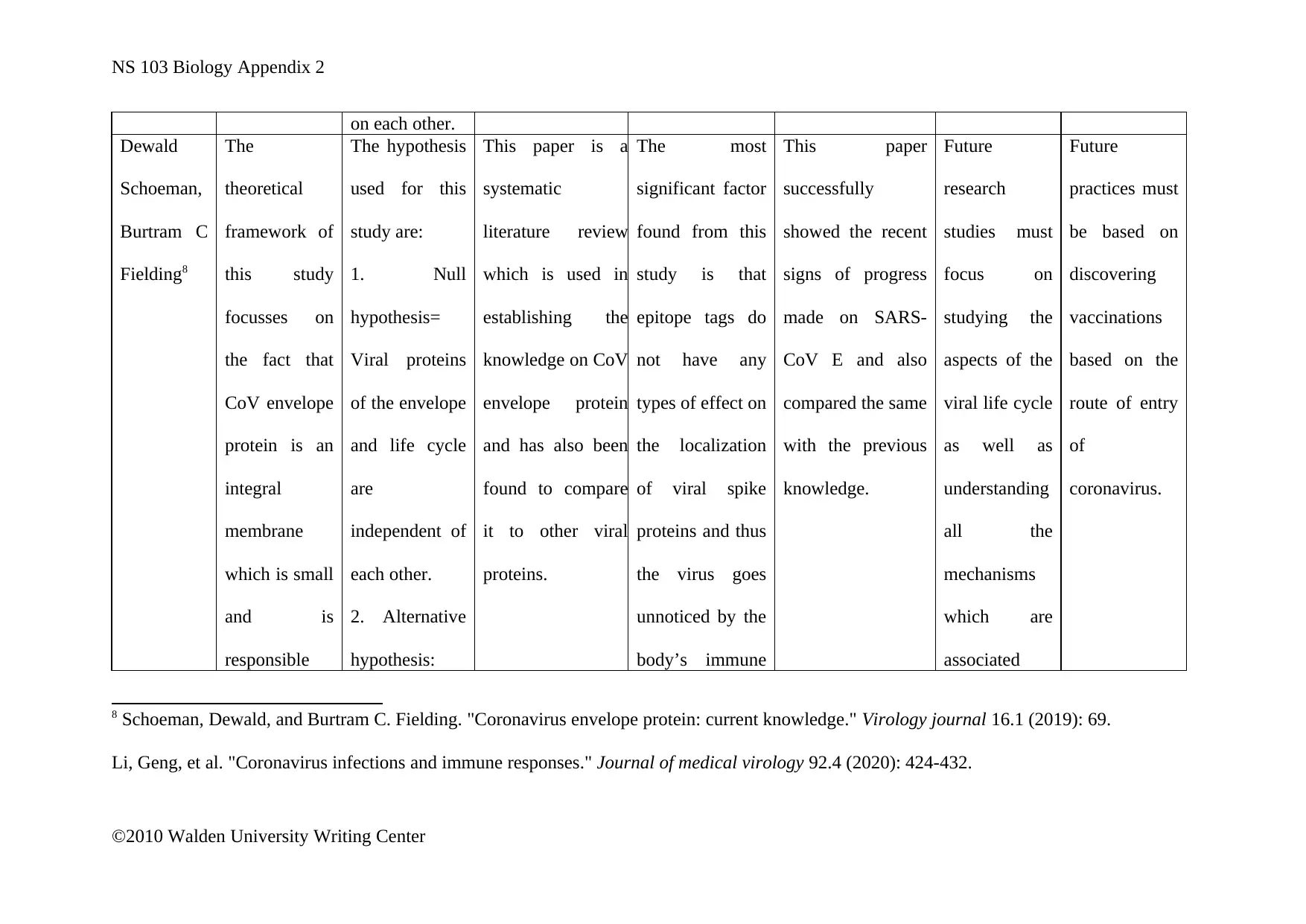
NS 103 Biology Appendix 2
on each other.
Dewald
Schoeman,
Burtram C
Fielding8
The
theoretical
framework of
this study
focusses on
the fact that
CoV envelope
protein is an
integral
membrane
which is small
and is
responsible
The hypothesis
used for this
study are:
1. Null
hypothesis=
Viral proteins
of the envelope
and life cycle
are
independent of
each other.
2. Alternative
hypothesis:
This paper is a
systematic
literature review
which is used in
establishing the
knowledge on CoV
envelope protein
and has also been
found to compare
it to other viral
proteins.
The most
significant factor
found from this
study is that
epitope tags do
not have any
types of effect on
the localization
of viral spike
proteins and thus
the virus goes
unnoticed by the
body’s immune
This paper
successfully
showed the recent
signs of progress
made on SARS-
CoV E and also
compared the same
with the previous
knowledge.
Future
research
studies must
focus on
studying the
aspects of the
viral life cycle
as well as
understanding
all the
mechanisms
which are
associated
Future
practices must
be based on
discovering
vaccinations
based on the
route of entry
of
coronavirus.
8 Schoeman, Dewald, and Burtram C. Fielding. "Coronavirus envelope protein: current knowledge." Virology journal 16.1 (2019): 69.
Li, Geng, et al. "Coronavirus infections and immune responses." Journal of medical virology 92.4 (2020): 424-432.
©2010 Walden University Writing Center
on each other.
Dewald
Schoeman,
Burtram C
Fielding8
The
theoretical
framework of
this study
focusses on
the fact that
CoV envelope
protein is an
integral
membrane
which is small
and is
responsible
The hypothesis
used for this
study are:
1. Null
hypothesis=
Viral proteins
of the envelope
and life cycle
are
independent of
each other.
2. Alternative
hypothesis:
This paper is a
systematic
literature review
which is used in
establishing the
knowledge on CoV
envelope protein
and has also been
found to compare
it to other viral
proteins.
The most
significant factor
found from this
study is that
epitope tags do
not have any
types of effect on
the localization
of viral spike
proteins and thus
the virus goes
unnoticed by the
body’s immune
This paper
successfully
showed the recent
signs of progress
made on SARS-
CoV E and also
compared the same
with the previous
knowledge.
Future
research
studies must
focus on
studying the
aspects of the
viral life cycle
as well as
understanding
all the
mechanisms
which are
associated
Future
practices must
be based on
discovering
vaccinations
based on the
route of entry
of
coronavirus.
8 Schoeman, Dewald, and Burtram C. Fielding. "Coronavirus envelope protein: current knowledge." Virology journal 16.1 (2019): 69.
Li, Geng, et al. "Coronavirus infections and immune responses." Journal of medical virology 92.4 (2020): 424-432.
©2010 Walden University Writing Center
Paraphrase This Document
Need a fresh take? Get an instant paraphrase of this document with our AI Paraphraser
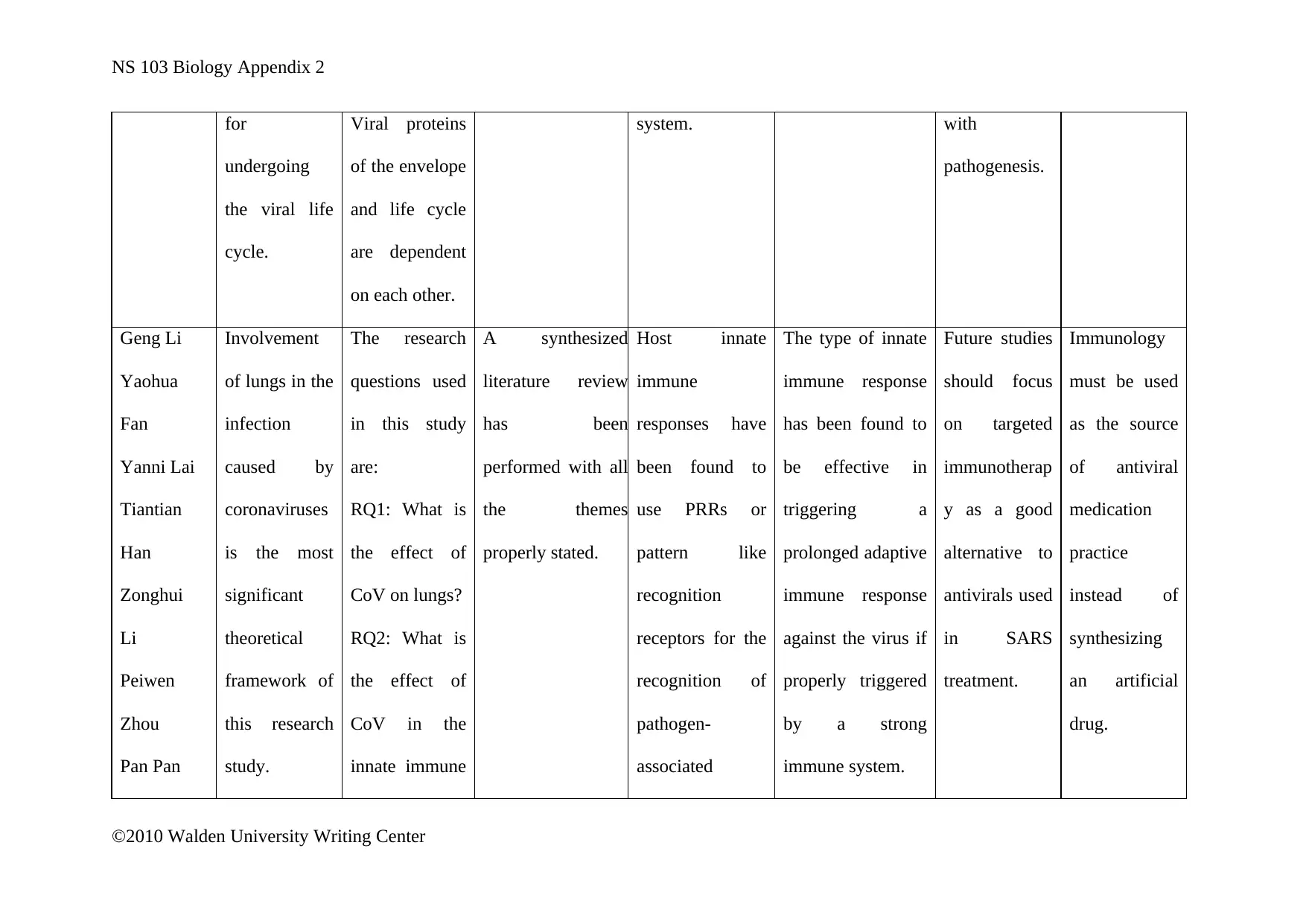
NS 103 Biology Appendix 2
for
undergoing
the viral life
cycle.
Viral proteins
of the envelope
and life cycle
are dependent
on each other.
system. with
pathogenesis.
Geng Li
Yaohua
Fan
Yanni Lai
Tiantian
Han
Zonghui
Li
Peiwen
Zhou
Pan Pan
Involvement
of lungs in the
infection
caused by
coronaviruses
is the most
significant
theoretical
framework of
this research
study.
The research
questions used
in this study
are:
RQ1: What is
the effect of
CoV on lungs?
RQ2: What is
the effect of
CoV in the
innate immune
A synthesized
literature review
has been
performed with all
the themes
properly stated.
Host innate
immune
responses have
been found to
use PRRs or
pattern like
recognition
receptors for the
recognition of
pathogen-
associated
The type of innate
immune response
has been found to
be effective in
triggering a
prolonged adaptive
immune response
against the virus if
properly triggered
by a strong
immune system.
Future studies
should focus
on targeted
immunotherap
y as a good
alternative to
antivirals used
in SARS
treatment.
Immunology
must be used
as the source
of antiviral
medication
practice
instead of
synthesizing
an artificial
drug.
©2010 Walden University Writing Center
for
undergoing
the viral life
cycle.
Viral proteins
of the envelope
and life cycle
are dependent
on each other.
system. with
pathogenesis.
Geng Li
Yaohua
Fan
Yanni Lai
Tiantian
Han
Zonghui
Li
Peiwen
Zhou
Pan Pan
Involvement
of lungs in the
infection
caused by
coronaviruses
is the most
significant
theoretical
framework of
this research
study.
The research
questions used
in this study
are:
RQ1: What is
the effect of
CoV on lungs?
RQ2: What is
the effect of
CoV in the
innate immune
A synthesized
literature review
has been
performed with all
the themes
properly stated.
Host innate
immune
responses have
been found to
use PRRs or
pattern like
recognition
receptors for the
recognition of
pathogen-
associated
The type of innate
immune response
has been found to
be effective in
triggering a
prolonged adaptive
immune response
against the virus if
properly triggered
by a strong
immune system.
Future studies
should focus
on targeted
immunotherap
y as a good
alternative to
antivirals used
in SARS
treatment.
Immunology
must be used
as the source
of antiviral
medication
practice
instead of
synthesizing
an artificial
drug.
©2010 Walden University Writing Center
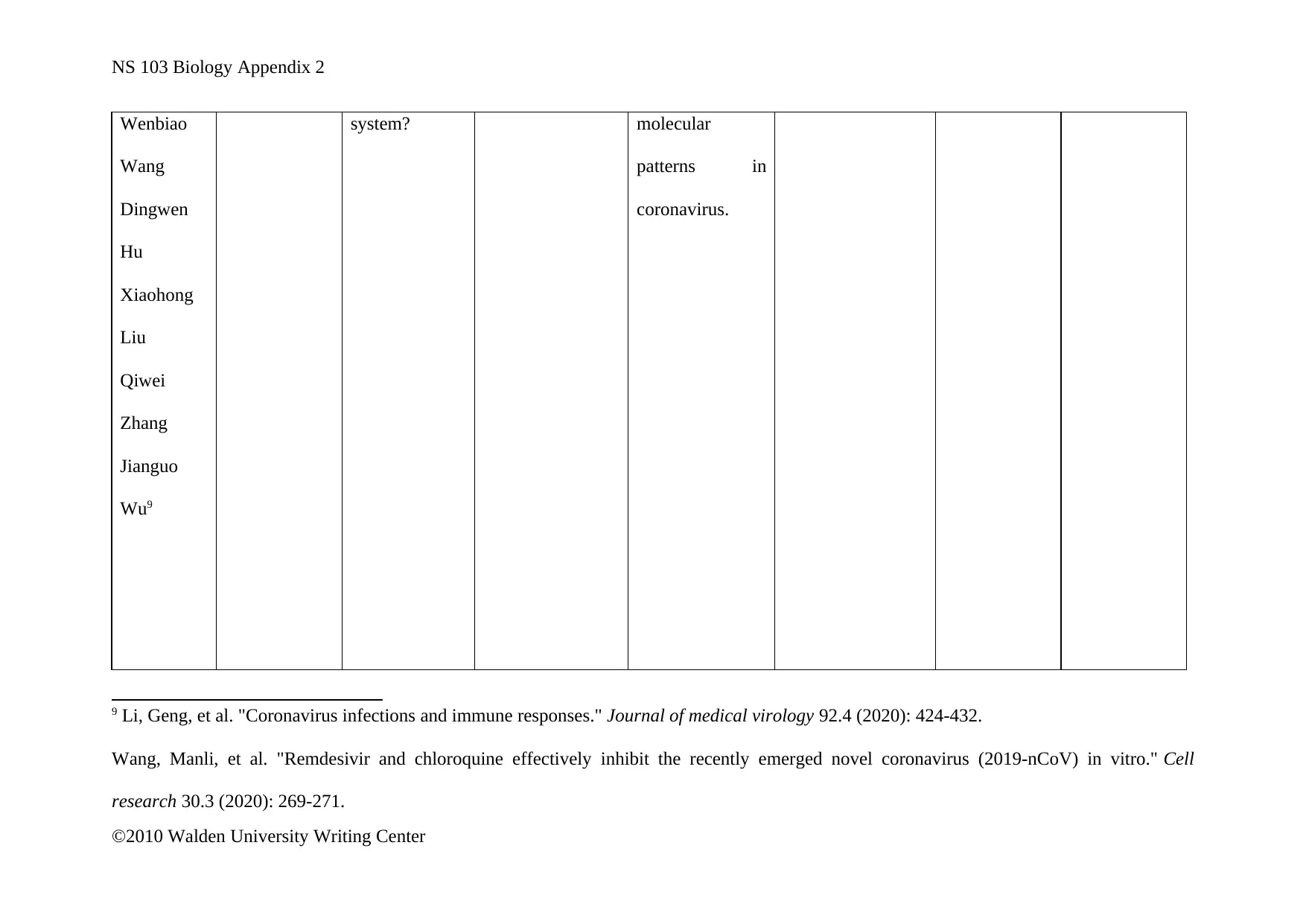
NS 103 Biology Appendix 2
Wenbiao
Wang
Dingwen
Hu
Xiaohong
Liu
Qiwei
Zhang
Jianguo
Wu9
system? molecular
patterns in
coronavirus.
9 Li, Geng, et al. "Coronavirus infections and immune responses." Journal of medical virology 92.4 (2020): 424-432.
Wang, Manli, et al. "Remdesivir and chloroquine effectively inhibit the recently emerged novel coronavirus (2019-nCoV) in vitro." Cell
research 30.3 (2020): 269-271.
©2010 Walden University Writing Center
Wenbiao
Wang
Dingwen
Hu
Xiaohong
Liu
Qiwei
Zhang
Jianguo
Wu9
system? molecular
patterns in
coronavirus.
9 Li, Geng, et al. "Coronavirus infections and immune responses." Journal of medical virology 92.4 (2020): 424-432.
Wang, Manli, et al. "Remdesivir and chloroquine effectively inhibit the recently emerged novel coronavirus (2019-nCoV) in vitro." Cell
research 30.3 (2020): 269-271.
©2010 Walden University Writing Center
⊘ This is a preview!⊘
Do you want full access?
Subscribe today to unlock all pages.

Trusted by 1+ million students worldwide
1 out of 18
Your All-in-One AI-Powered Toolkit for Academic Success.
+13062052269
info@desklib.com
Available 24*7 on WhatsApp / Email
![[object Object]](/_next/static/media/star-bottom.7253800d.svg)
Unlock your academic potential
Copyright © 2020–2025 A2Z Services. All Rights Reserved. Developed and managed by ZUCOL.


